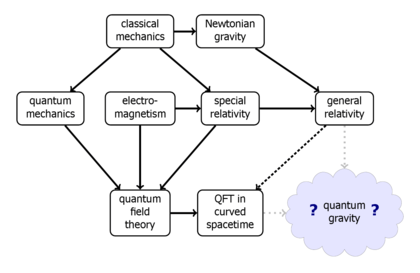
Diagram showing where quantum gravity sits in the hierarchy of physics theories
Quantum gravity (QG) is a field of theoretical physics that seeks to describe gravity according to the principles of quantum mechanics, and where quantum effects cannot be ignored.
Quotes
- ... our most fundamental concept, that of spacetime, is itself being threatened as we probe the quantum nature of dynamical spacetime of quantum gravity.
- David Gross, The Future of Particle Physics - David Gross - 5/12/2018. Caltech (22 May 2018). (quote at 44:39 of 49:51)
- Gravity's weakness makes it very difficult to measure its quantum effects; as a result, we have no experimental data to guide theoretical physicists in the development of the missing theory. Detecting a “graviton" – the hypothetical particle making up part of a gravitational field – would require a particle collider the size of the Milky Way or a detector with a mass of the planet Jupiter. These experiments are so detached from our technological capabilities that physicists have focused on trying to remove the mathematical contradictions first, developing approaches like string theory, loop quantum gravity, and asymptotically safe gravity. But to know which theory describes physical reality, experimental tests must eventually be developed.
- Sabine Hossenfelder, "One Hundred Years of Relativity" (May 6, 2015)
- Hawking's intitial foray into quantum gravity was more modest than Wheeler's and other[s]... a sneak approach. He first wanted to know what the effect was of an ordinary, classic, curved-space gravitational field on a quantum system. He called this the semiclassical approach. Until that day, most quantum calculations had been done as if gravity didn't exist—they were hard enough without it in normal flat space-time... [Hawking accomplished this by] envisioning an "atom" whose nucleus was a catastrophically powerful black hole... Starobinsky ventured the opinion that rotating black holes would spray elementary particles. ...It was known from Penrose's work, among others, that you could extract energy from the spin of a black hole just like any other dynamo... in particles and radiation just like it did from a particle generator. ...But Hawking ...resolved to redo the calculation for himself ...he decided to warm up first, by calculating the rate of emission from a nonrotating quantum hole. He knew the answer should be no emission. ...his results were embarrassing. His imaginary black hole was spewing matter and radiation... he was reluctant to tell anybody but his closest friends; he was afraid Bekenstein would hear about it. ...It meant that holes had temperatures, just as Bekenstein's work implied.
- Dennis Overbye, Lonely Hearts of the Cosmos: The Scientific Quest for the Secrets of the Universe (1992) pp. 111-112
- ... it would be a bracing achievement, and major progress, to identify any concrete, observable phenomenon that brings in truly characteristic features of quantum gravity beyond the semiclassical approximation in common use. Actual observation would bring the subject to another level.
- Frank Wilczek: (April 2016)"Physics in 100 years". Physics Today 69 (4): 32–39. DOI:10.1063/PT.3.3137. (quote from p. 36)
External links
This article is issued from
Wikiquote.
The text is licensed under Creative
Commons - Attribution - Sharealike.
Additional terms may apply for the media files.